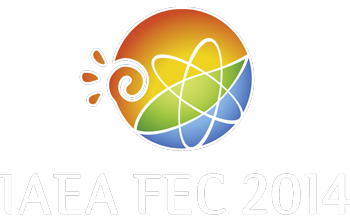Speaker
Dr
C. Craig Petty
(General Atomics)
Description
The natural attributes of the hybrid scenario, especially the anomalously broad current profile that suppresses sawteeth by maintaining the safety factor minimum (qmin) above unity, allows steady-state conditions with zero surface loop voltage to be achieved in 1 MA discharges in DIII-D with efficient central current drive and simultaneous high beta and high confinement. Steady-state hybrid plasmas can achieve βN=3.6 for the full duration of the NB pulse (>1 τ_R) without exciting the deleterious m/n=2/1 tearing mode, corresponding to βT up to 3.4%. The experimental βN exceeds the DCON-calculated no-wall n=1 stability limit by 20%. With central current drive, the surface loop voltage is driven down to zero for >1 τ_R when the poloidal beta is increased above 1.9 by raising the EC power to 3.05 MW and reducing IP from 1.1 MA to 1.0 MA. High-β hybrids can have slightly more than 50% bootstrap current fraction despite qmin≈1; the other half of the plasma current is driven efficiently using central EC and NB current drive. Inside of the q=3/2 surface the current profile is strongly overdriven, and time dependent TRANSP modeling shows that qmin should drop to ~0.8 by the end of the discharge. The fact that qmin remains above unity and sawteeth are suppressed shows that the hybrid scenario maintains an anomalously broad current profile even in the presence of strong central current drive. The thermal energy confinement time is excellent, with confinement factors of up to H98y2=1.6 even during strong central EC heating. The experimental density and temperature profiles are well reproduced by the TGLF transport model, and measured changes in electron thermal transport, due to shape-induced pedestal changes or electron heating, parallel the predicted changes in the level of high-k turbulence. A zero-dimensional physics model demonstrates that attractive scenarios with Qfus=3.5–3.8 exist for steady-state operation in ITER and FNSF using central EC current drive, with higher Qfus possible using higher efficiency NB current drive. Therefore, high-β hybrid plasmas with central current drive should be considered as an alternative method for achieving the fusion performance goals in steady-state scenarios in ITER and FNSF.
This work was supported in part by the US Department of Energy under DE-FC02-04ER54698, DE-FG02-04ER54761, DE-AC52-07N27344, and DE-FG02-08ER54984
| Country or International Organisation | USA |
|---|---|
| Paper Number | PPC/P2-36 |
Author
Dr
C. Craig Petty
(General Atomics)
Co-authors
Mr
A. M. Garofalo
(General Atomics)
Dr
Al Hyatt
(General Atomics)
Dr
Christopher T. Holcomb
(Lawrence Livermore National Laboratory)
Mr
E. J. Doyle
(University of California-Los Angeles)
Dr
Francesca Turco
(Columbia University)
Dr
Gary L. Jackson
(General Atomics)
Dr
John Ferron
(General Atomics)
Dr
Jon Kinsey
(General Atomics)
Dr
Timothy C. Luce
(General Atomics)

